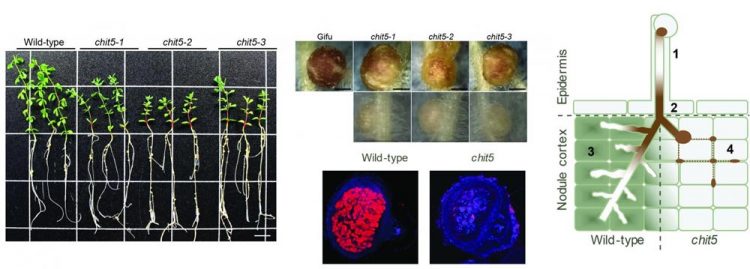Goldilocks principle in biology — fine-tuning the 'just right' signal load

The concentrations of Nod factor are controlled by CHIT5 and this is important for establishing functional symbiosis (red nodules) versus defect symbiosis (white nodules). Credit: Kasper Røjkjær Andersen, Simon Kelly and Simona Radutoiu. Usage Restrictions: Image may be used only to illustrate the research described in the accompanying release.
Trying to transfer to other types of plants.
More specifically, in their new studies, the researchers found that the chitinase CHIT5 present in legume roots is required for Nod factor hydrolysis and functional symbiosis. Their work reveals a new and crucial role of the legume host in modulating levels of specific rhizobial Nod factor morphogens during cortical infection to ensure functional symbiosis.
Morphogens are key signals for organized development in multicellular organisms. The crucial role of self-produced morphogens like retinoic acid or transformation growth factor-beta during embryo development has been long demonstrated.
Molecules of microbial nature have also been shown to induce a morphogenetic response in symbiotic eukaryotic hosts, and recently gained an increased attention following the increased focus on microbiome studies. The nitrogen-fixing root nodules are lateral organs induced by a microbial morphogen. In their new studies, the researchers reveal for the first time that a developmental switch in the legume plant is ensured by the host-controlled modulation of microbial morphogen, Nod factor.
Deepening our understanding of Nod factor signalling
Nod factors have been known for decades as signalling molecules produced by rhizobia to trigger and enable dinitrogen-fixing symbiosis. In addition to their signalling capacity, Nod factors have been considered morphogens based on their effect on host developmental programmes; nodule organogenesis and infection thread formation. The researchers have found that the model legume Lotus japonicus modulates the levels of the Nod factor morphogen via CHIT5 to control colonisation of nodule primordia.
chit5 mutants display an unbalanced symbiotic signalling reminiscent of what is seen in developmental arrest at an early primordia stage. We believe that our work provides the basis for a novel layer of symbiosis research, enabling a deeper understanding of Nod factor signalling during cortical infection with direct consequences for the switch to nitrogen-fixing status.
This knowledge becomes especially essential in the context of the research group's current ambitious engineering projects aiming at transferring the nitrogen fixation ability to non-legumes, which could potentially have great agricultural importance.
###
The results have just been published in the international journal eLife:
“A plant chitinase controls cortical infection thread progression and nitrogen-fixing symbiosis”
Anna Malolepszy*, Simon Kelly*, Kasper Kildegaard Sørensen, Euan Kevin James, Christina Kalisch, Zoltan Bozsoki, Michael Panting, Stig U Andersen, Shusei Sato, Ke Tao, Dorthe Bødker Jensen, Maria Vinther, Noor de Jong, Lene Heegaard Madsen, Yosuke Umehara, Kira Gysel, Mette U Berentsen, Michael Blaise, Knud Jørgen Jensen, Mikkel B Thygesen, Niels Sandal, Kasper Røjkjær Andersen, and Simona Radutoiu.
DOI: 10.7554/eLife.38874
For further information, please contact
Associate Professor Simona Radutoiu
Department of Molecular Biology and Genetics
Aarhus University, Denmark
radutoiu@mbg.au.dk – +45 87155498
Media Contact
All latest news from the category: Agricultural and Forestry Science
Newest articles

NASA: Mystery of life’s handedness deepens
The mystery of why life uses molecules with specific orientations has deepened with a NASA-funded discovery that RNA — a key molecule thought to have potentially held the instructions for…

What are the effects of historic lithium mining on water quality?
Study reveals low levels of common contaminants but high levels of other elements in waters associated with an abandoned lithium mine. Lithium ore and mining waste from a historic lithium…

Quantum-inspired design boosts efficiency of heat-to-electricity conversion
Rice engineers take unconventional route to improving thermophotovoltaic systems. Researchers at Rice University have found a new way to improve a key element of thermophotovoltaic (TPV) systems, which convert heat…



